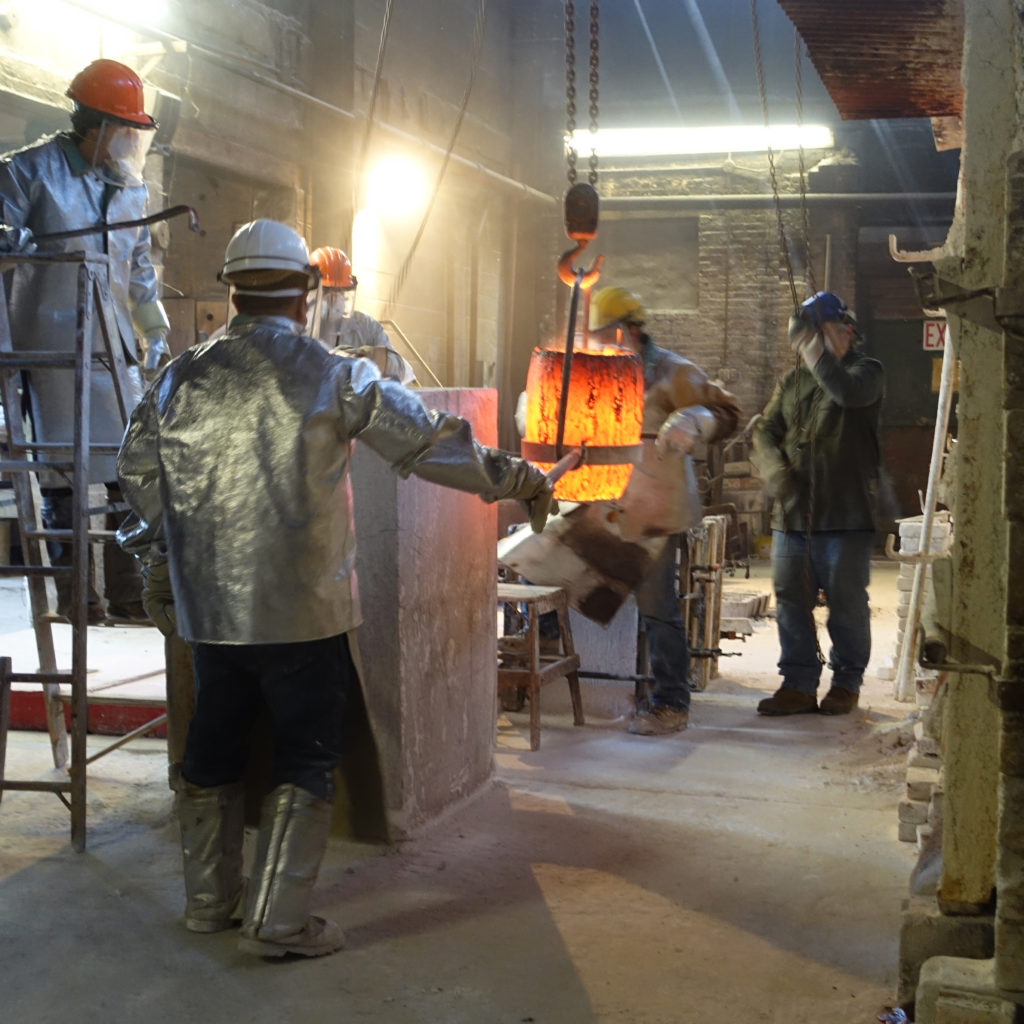The video of this post is public on YouTube.
I lived in New York City for three decades without suspecting that the Modern Art Foundry was casting bronze sculptures just a few miles from my home. Most famous among them is Jose Creeft’s Alice in Wonderland, in Central Park – but they’ve been at work since 1932, so there are many, many more of their works in New York City, around the country, and around the world.
Last week I toured the Foundry while several sculptures were being cast. What a wonderful day! Many thanks to Jeffrey Spring, who runs the Foundry with his sister Mary Jo, for taking the time to show us around. Thanks also to my friend G.A. Mudge for making the arrangements for our visit.
The photos below are from that visit. They’re also a short course on the “lost wax” process, which has been used for millennia to create metal sculptures. If you’re on my Sunday Recommendations list, you’ve seen quite a few works created by the lost-wax process.
Preparation for casting
A sculptor brings a model to the Foundry: it might be made of plaster, clay, wood, or some other material. At the Foundry, the first step in making a bronze sculpture is to make a rubber mold of the model. (From this point on, I’ll only mention bronze, but the Foundry casts in several other metals as well.) The inside of the rubber mold – pink in the photo below – is then painted with a quick-drying red wax that captures all the detail on the surface of the mold.
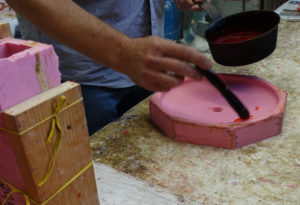
On top of the red wax goes a layer of thicker brown wax. The brown wax dries from the mold-side out. As soon as the dry layer is about 1/4 inch thick, the rest of the wax is poured out. This double-thickness of wax, the red plus the brown, will eventually be the thickness of the finished bronze piece. In the photo below, the rectangular red object in the foreground is a red-and-brown wax piece created from the pink mold at the left. On the right is a pink mold partially filled (for demonstration purposes) with a thin layer of red wax followed by a pool of brown wax.
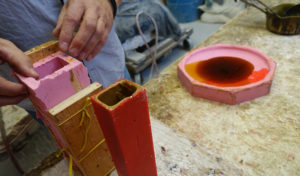
The rubber mold can now be peeled off. At this point, the sculptor may come to the Foundry to check that the red wax has all the detail he wants … because in the next steps, his work will become difficult, and then impossible, to see.
The molten bronze will eventually be poured into the shape of the wax. To allow that, wax “gates” are attached to the wax. The object in the photo below is a seated human figure leaning slightly forward. (Rubber molds for this sculpture would have been made in several sections from the artist’s model.) The brown shape at the top – a Starbucks cup covered in brown wax – will eventually form the hole where the bronze is poured in, so most of the gates lead down from it.

As molten bronze flows into the gates, the air within the gates has to be able to escape. So in the photo above, the gates that emerge from the Starbucks cup go directly to the bottom of the figure. The gates branching off of them are pointed upwards, so the bronze can’t flow into them until the area below them is all filled. As the bronze fills the figure from the bottom up, the air escapes through the two gates at the very top, near the Starbucks cup.
The figure below has been filled with crushed refractory material: it’s that white stuff visible toward the upper left, where part of the arm is missing. (“Refractory material” means “stuff that doesn’t care if it comes in contact with 2,000-degree-Fahrenheit molten metal.”) Steel nails are driven into the wax and into the crushed refractory material behind it. Steel doesn’t melt until 3,000 degrees, so the nails won’t melt and mix with the bronze. In the figure below, nails are visible on the knee, abdomen, and elsewhere.
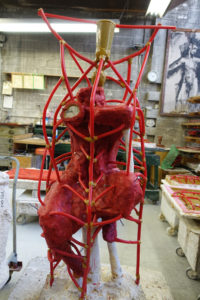
The nails are easier to see on this piece, part of a model for a bronze table.
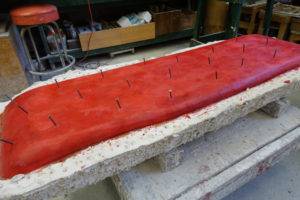
Next, the red wax is carefully covered with a layer of refractory material that’s been mixed into a slurry the consistency of sour cream. The inside of this layer will give the exterior of the final bronze its shape, so it has to be applied very carefully, to capture all the details in the red wax – which, you remember, was applied very carefully to capture all the details of the original model. After the fine layer of stone is applied, layers of coarser stone are added, until the shape is barely recognizable.

A thin layer of refractory material has been applied to this piece. The spout and air vents are visible at the top.
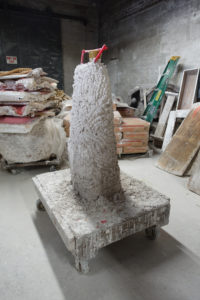
Here’s a figure with more stone applied on the outside. This isn’t the figure we saw in red wax above: it’s another that happened to be in progress the day I visited.
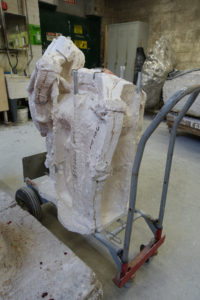
The whole business – inner core, wax, nails, outer core – now gets framed into a box of concrete panels. All the gaps within the box are filled in with a wet mixture of ground stone. Why? Because molten bronze would very much like to flow all over the place. The compacted stone keeps it from doing that.
The sculpture is now completely unidentifiable within its concrete box. It’s labelled with the artist’s name and the weight of bronze that will be needed to fill it. The weight is calculated by keeping track of how much red and brown wax it took to create the wax model.
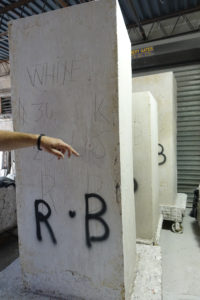
Last step before casting: the concrete box is put into a furnace for a day or so. The wax melts out. The core, the exterior, and all those steel nails keep the now air-filled spaces exactly where the wax used to be. In this photo, you can see the wax puddling out at lower right.

The Pour
The day I visited the Foundry, they were casting two small pieces and one larger one. In the photo below, the molds are in the left foreground.
The staff places a graphite crucible in a furnace and fills it with bronze ingots. When the ingots have melted, the crucible is lifted out with a massive pulley.
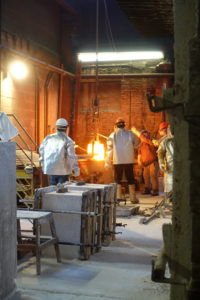
Bronze is an alloy: when it’s heated, some impurities rise to the surface. Here a staff member skims them off and tosses them on the ground.

The staff moves the crucible toward the first mold.
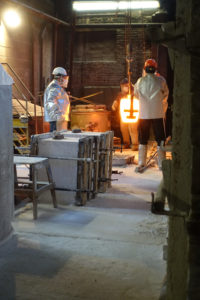
The staff pours bronze into the second mold. When steam no longer emerges from the two vents at the top (remember the two vents at top?), the mold is full.
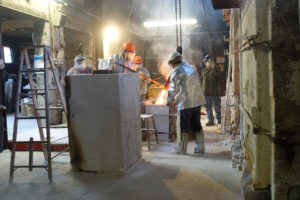
Below, the staff moves the crucible to the largest of the molds. The man closest to us is holding one of the two handles that tip the crucible once it’s properly positioned.
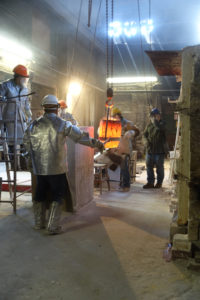
If the mold is very large, it’s set into a pit in the floor (left foreground), where the surrounding concrete can be used to help support it.
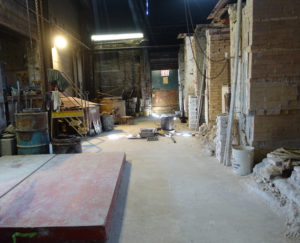
After the pour
Bronze that’s left over after the molds are filled is poured into ingot molds. The ingots can be used in future castings along with virgin ingots, such as the one in the center foreground. Within a couple hours, the crucible has returned to normal gray color. Those bright white spots are not heat but sunlight.
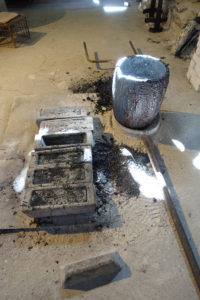
The largest crucible in this photo, toward the back, holds about 350 lbs. of bronze. That’s enough for a life-size sculpture. At lower right is one end of the handles that tilts the crucible when it’s over the mold.
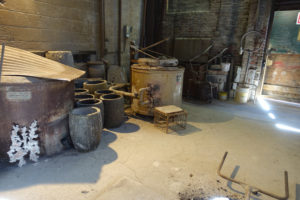
The molds that have just been filled will sit for a day so that the quarter-inch thick bronze can cool. If the bronze were solid, the cooling process would take much longer and would be uneven, creating cracks and pockets in the metal. And the sculpture would be enormously heavy and expensive, as well.
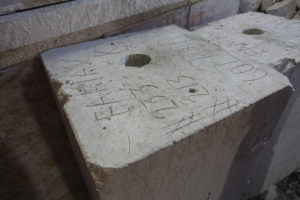
When the metal has cooled, the outer shell is smashed away. Those long ridges were the red wax gates. Now they’re bronze instead.
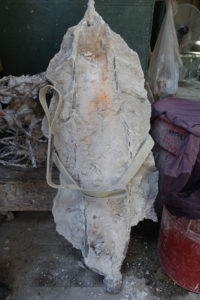
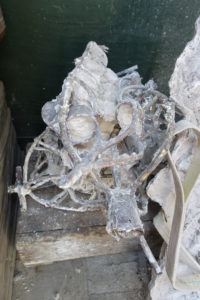
The refractory material is saved and ground up, for use as cores in future sculptures.

Finishing
Below, all the exterior mold of a piece has been chipped off. Jeffrey Spring shows how the bronze gates will be removed, as well as some lacy bits where the bronze ran into voids in the exterior mold. The bronze that’s removed is saved for future use.
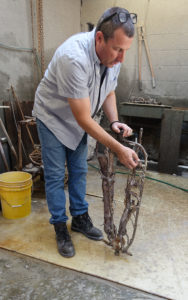
The piece gets a bath in sulphuric acid, which temporarily turns it pinkish. The piece on the ledge is a horse for the Breeders’ Cup trophy.
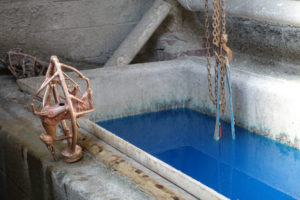
A member of the Foundry’s staff repairs the area where the gates were detached and also any minor flaws in the casting. The interior core is removed. If it’s not, and the sculpture is placed outdoors, the refractory material will leach through the bronze and discolor it. In the photo below, the standing figure has been finished and a patina has been added. The piece lying down, by the same artist, has yet to be cleaned.
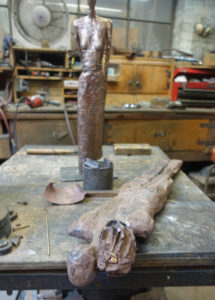
The final step in creating a bronze sculpture is to add a patina. A patina is not an added color, but a chemical reaction with the outer layer of the bronze. There are many options for a patina: see photo below.

Charles E. Gagnon’s The String Quartet
Gagnon (1934-2012) was inspired by his love of string quartets to create these four life-size figures, which were cast at the Modern Art Foundry. I can almost hear the music!
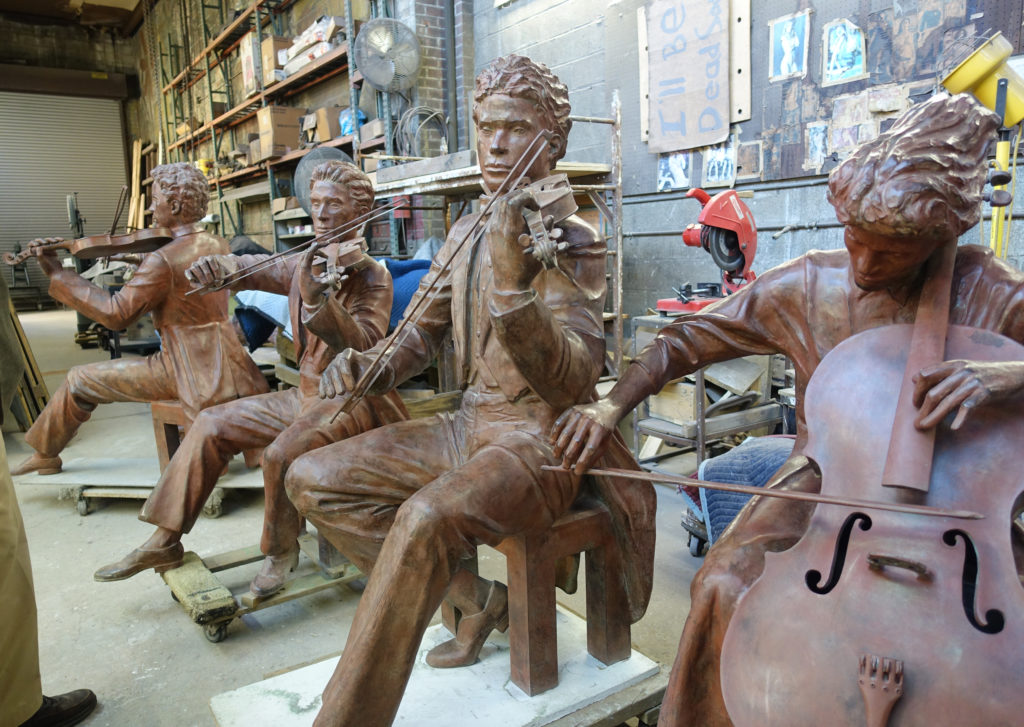
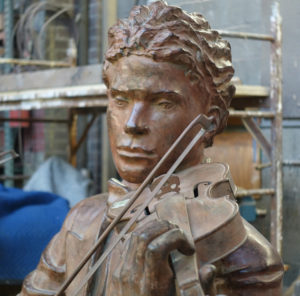

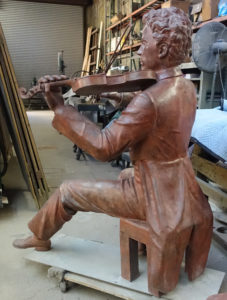
When I was approaching the Modern Art Foundry, I was intrigued by these figures peering out from behind the working gate. It turns out they’re several more copies of The String Quartet.
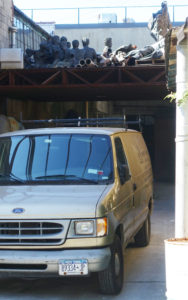
Modern Art Foundry’s logo, in bronze
Today’s protective gear is a bit more all-encompassing than this!
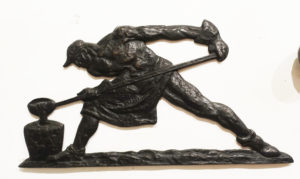
More
- The Modern Art Foundry is located at 18-70 41st St., Astoria, New York, 11105. For a tour or for information on their casting, preservation, and conservation services, call 718-728-2030 or email info@modernartfoundry.com.
- My post on the Darrow sculpture in Dayton, Tennessee, has a photo of a patina being applied to raw bronze. In the Hamilton sculpture at the Coast Guard Academy, Ben Victor used several different patinas.
- In Getting More Enjoyment from Sculpture You Love, I demonstrate a method for looking at sculptures in detail, in depth, and on your own. Learn to enjoy your favorite sculptures more, and find new favorites. Available on Amazon in print and Kindle formats. More here.
- Want wonderful art delivered weekly to your inbox? Check out my free Sunday Recommendations list and rewards for recurring support: details here.
